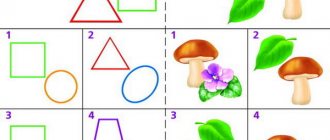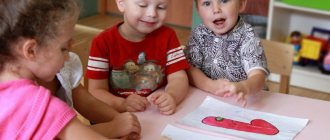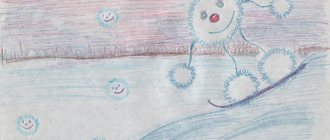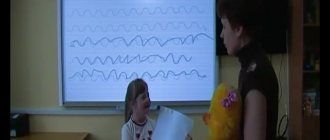Iris folding - rainbow folding
Iris folding originated in Holland. This technique is also called "rainbow folding". Its principle is as follows:
1. The required fragment of the picture is cut out along the contour.
2. On the reverse side, strips of colored paper are glued onto the drawing strictly in a certain order, in accordance with a pre-prepared template or a diagram drawn up by you.
3. The wrong side is sealed with a clean sheet of paper.
4. The drawing, if necessary, is supplemented with details.
Before you start working, you need to learn how to build a template yourself or stock up on ready-made Iris templates.
Unconventional technique of appliques from different types of cereals
Author: Sotnikova Svetlana Anatolyevna,
teacher of the highest qualification category
MADO CRR-kindergarten No. 158 in the city of Tyumen.
Topic: “Unconventional technique of applications from different cereals”
Goal: To introduce teachers to the non-traditional technique of appliques from different cereals. Show techniques and stages of application.
Objectives: Learn to create images using various grains. Correctly, evenly place the composition on a sheet of paper. Encourage teachers to use non-traditional cereal appliqué techniques to develop children's creativity, imagination, tactile sensation, fine motor skills and creative potential, as well as the ability to work and achieve the desired result. Develop thinking, speech, accuracy, volitional qualities such as attention, endurance, perseverance. The ability to develop interest in artistic and aesthetic activities. Support the creative abilities of teachers and increase their self-esteem.
Equipment: Various cereals, trays, plasticine, napkins, stacks, A4 sheets with drawn compositions.
Preliminary work:
Planting cereals, experience with cereals
Part 1 - introductory.
Application from cereals brings novelty to our activities, makes it interesting and exciting. Teaches to distinguish colors, shapes, improves the eye. The application is of great importance for the comprehensive development and education of preschool children.
® In mental education – forms mental operations, analysis, synthesis, comparison, generalization, and develops children’s speech. Children master the correct verbal designations of directions (left, right, middle, corners, top, bottom).
® In sensory education - direct, sensitive acquaintance with objects and phenomena.
® In moral education - develops moral and volitional qualities: to bring the work started to the end, to study with concentration and purpose, to help a friend, to overcome difficulties.
® In labor education, it develops hard work. Children prepare the material for application and put it away.
® In aesthetic education – develops artistic taste.
Part 2 main.
Apply plasticine to the composition, choosing the desired color. Sprinkle with cereal, choosing the desired color and volume. Press the cereal into the plasticine with your fingers. If necessary, you can make the necessary additions to the image with plasticine.
Part 3 is final.
Exhibition of works.
Presentation of previously completed children's work.
Bibliography:
1. Adzhi, A. V. Notes of integrated classes in the senior group of kindergarten. Cognitive development. / A.V. Aji. - M.: TC "Teacher", 2006. - 336 p.
2. Take care of living things. Game didactic material on ecology. - M.: St. Petersburg. [and others]: Peter, 2013. - 196 p. 3. Bykova, N.M. Games and exercises for speech development / N.M. Bykova. - M.: Detstvo-Press, 2010. - 160 p. 4. Volkov, B. S. Teaching young children to communicate. Methodical manual / B.S. Volkov, N.V. Volkova. - M.: Sfera, 2013. - 128 p. 5. Volchkova, V. N. Lesson notes in the senior group of kindergarten. ISO. Practical guide for educators and methodologists of preschool educational institutions / V.N. Volchkova, N.V. Stepanova. - M.: TC "Teacher", 2008. - 873 p. 6. Gallery of emotions. What are you feeling now? Psychological poster. - M.: Genesis, 2015. - 800 p. 7. Gladysheva, N. N. Teacher’s work program. Daily planning of educational activities with children 3-7 years old in a mixed age group. March-May / N.N. Gladysheva, I.N. Khramov. - M.: Uchitel, 2014. - 168 p. 8. Emelyanova, E. L. Tell children about nature. / E.L. Emelyanova. - M.: Mozaika-Sintez, 2012. - 241 p. 9. Ilyina, S.K. Lekoteka in a preschool educational institution. Organization, documentation / S.K. Ilyina. - M.: Sfera, 2011. - 128 p.
“Certificate of publication in the media” Series A No. 0005837
We invite teachers of preschool education in the Tyumen region, Yamal-Nenets Autonomous Okrug and Khanty-Mansi Autonomous Okrug-Yugra to publish their teaching materials: - Pedagogical experience, original programs, teaching aids, presentations for classes, electronic games; — Personally developed notes and scenarios of educational activities, projects, master classes (including videos), forms of work with families and teachers.
Why is it profitable to publish with us?
1. “Kindergartens of the Tyumen Region” is an officially registered specialized media outlet at the federal level. 2. The activities of the editorial office are supported by the Department of Education and Science of the Tyumen Region 3. We issue a “Certificate of Publication” in the media. 4. The document has a unique number, is entered in the register, has the original seal of the editorial office of the online publication and signature. 5. “Certificate of publication” in the media is sent to the author in both paper and electronic versions.
Details >>>
Sample “Certificate of publication of author’s methodological material in the media.”pdf
Share
Reverse applique
This is an application in reverse. It is performed on a smooth and transparent surface of plastic or glass, and its reverse side becomes the front side.
The most important thing is to make a good, clear drawing on paper, which is placed under the inverted lid.
To prevent it from moving, it must be attached to the lid with two peas of white plasticine.
The outline of the future design is laid out with black plasticine, and the open areas are sequentially filled with colored plasticine.
Turned over with the smooth side facing you, the product makes an amazing design for a painting or panel.
After finishing, the application is covered with a circle of colored cardboard.
The idea of this technique belongs to Tatyana Prosnyakova, the author of numerous books on artistic work and the creator of the Internet site “Country of Masters.”
This application can be done using several methods: laying out a contour of flagella, mosaic of plasticine balls
It is recommended to conduct such classes with children aged 3 years and older.
“Indentation” technique
1. We will need a blank: a color drawing or the simplest paper applique. In the photo, a paper applique is used as a blank - a silhouette of a tree glued to colored cardboard.
2. Then we apply plasticine circles, carefully leveling the edges.
3. We invite the child to decorate the circles with cereals (or coffee beans, nuts, seeds, etc.) - press them into plasticine.
4. We also make a tree trunk. Apply brown plasticine, forming the silhouette of a tree.
If the tree is winter, you can sprinkle the plasticine trunk with coarse salt, and then press the salt crystals into the plasticine.
That's all! It couldn't be simpler.
Fluffy applique
Application made from rolled napkins is a simple and accessible form of creativity for any age that promotes the development of children’s fine motor skills.
To work, you will need paper napkins of various colors, a contour drawing of the future application (for this it is convenient to print children’s coloring books on printer paper), PVA glue, and colored cardboard as the basis for the application.
The napkins are cut into equal squares, then each square is rolled into a ball using your fingers.
The resulting balls are glued according to the pattern using PVA glue.
First, the appliqué is done on printer paper on which the design is printed. The finished applique must dry well, after which the design is cut out and pasted onto the background - colored cardboard.
The final finishing of the panel depends on the imagination of the author: depending on the theme, the work can be decorated with natural materials, threads, shells, shavings, etc.
Individual details of the composition can be made from colored paper - plain or velvet.
The author of these works is Tatyana Cherednichenko.
Mosaic
Another very exciting way to create creative works is to make a mosaic from cut out or torn pieces of paper, multi-colored eggshells.
It is done in two ways: from separately cut multi-colored small shapes (squares, triangles, trapezoidal parts, stripes) and by cutting several layers of the base in a patterned form, then changing the parts according to color in the background slots and fastening them with glue.
Think over the drawing, mark it with a pencil outline and, having previously smeared the surface with glue, fill the drawing with the color that you need to create your idea.
Abstract of GCD for the senior group, using non-traditional appliqué techniques.
Completed by: Kozyreva Marina Petrovna.
Place of work: Ulyanovsk, MBDOU TsRR d\s No. 14
Position: Educator.
Abstract of GCD for the senior group, on non-traditional application.
Lesson topic:
"Magic squirrel"
Purpose of the lesson:
To familiarize children with one of the types of non-traditional appliqué techniques.
Objectives:
Getting to know a new technique - gluing finely chopped threads onto a silhouette;
Training in dexterity in handling various materials;
Development of the ability to work hands with visual perception;
Development of imagination and creative activity;
Development of memory, attention, thinking, speech, eye, cognitive interest;
Cultivate perseverance, accuracy, goodwill, and the ability to work in a team and individually.
Equipment:
Sample of work, an envelope with a silhouette of a squirrel, glue, a brush, a napkin, scissors, felt-tip pens, a basket with balls of thread of different colors, a squirrel toy, a laptop with a presentation “photos of squirrels.”
GCD move:
Teacher (B):
Guys, an interesting guest came to our lesson today, and you will find out who it is if you guess the riddle:
It jumps from branch to branch, but rarely comes down to the ground. The small, fragile body always wears a fur coat. The claws on the paws are sharp: It’s not easy to run up the trunk! This red-haired... (squirrel) (a toy squirrel appears from behind the screen).
IN:
Meet guys, this is a squirrel and her name is Bella. Oh, and our squirrel didn’t come with empty paws, she brought something, but what will you learn from the riddle:
Followed by needles, well known to everyone, cannot walk ahead, a needle will pave the way for her ( thread)
IN:
Well done guys, you got it right!
Our Bella brought with her a whole basket of balls. Let's look at them and touch them. Who can tell what kind of balls these are? What can be made from them? (children's answers)
Q:
Guys, do you know that Bella came to us for a reason, she came to us for help.
For her birthday, she decided to make a photo album with photos of all her squirrel friends. What color do you think squirrels can be? Let's watch a presentation of photographs of our Bella's friends (on a laptop, the teacher shows various pictures of squirrels of different colors, discussing their appearance with the children).
IN:
Bella was so happy with the photographs she took, but they turned out to be black and white
(showing the children a printed silhouette of a squirrel from an envelope)
Q:
That's why Bella came to us for help.
After all, photographs should be colored, bright and not black and white. How can we help her? (children's answers). Q:
Do you remember what Bella brought with her?
She brought us her favorite basket of balls. Why did she bring it? (children's answers). Q:
That’s right, guys, today we will help our Bella and make an unusual applique, and the applique using chopped threads, so we will make her black and white squirrels colored!
Applications made of cotton wool and poplar fluff
The fluff of the poplar, which every spring covers lawns and city streets with “white snow”, flies into the open windows of houses, causing displeasure among residents, but it turns out that it can also delight them.
Appliqués made of poplar fluff are monochromatic, they resemble grisaille (a decorative type of painting done in different shades of one color - usually gray). Delicate, airy, graceful. When choosing themes for appliqués made of poplar fluff, you must keep in mind that it is easier to work if there are few details and if they are not small.
It is better to choose animals, birds, and plants with a fluffy texture. For example: bunnies, kittens, ducklings, chicks, plush toys, dandelion heads.
It is easier to make applications from black and white drawings and contrasting photographs.
In the plot application, winter landscapes, birch groves, fish in an aquarium are successful.
Using appliques made of cotton wool or poplar fluff, you can make fluffy, voluminous animals, snow, depict the fluff of plants, clouds - the scope for imagination is very wide.
From small cotton balls you can make a poodle and a lamb, from thinned and torn pieces of cotton wool you can make clouds, from cotton pads you can make chickens and flowers, snowmen.
Remember that cotton wool can be tinted with watercolors or gouache, and then the scope for creativity and imagination will increase several times.
Confetti applique
People use pieces of paper punched with a hole punch in different ways. Well, how they use it: they throw it away, or they give it to children to play with, and then they throw it away anyway. I suggest you create pictures from it yourself or together with your children. It all depends on your imagination and desire. Description of work:
1. Draw, for example, the outline of a butterfly. 2. Invite the child to apply glue over the entire surface of the drawing with a brush, or if he does not have the skill to work with it, then with a sponge. 3. Let the confetti sprinkle heavily over the entire piece of paper. 4. Let the baby shake off the excess from the sheet of paper (you can simply turn the sheet upside down). 5. Together, be surprised by the butterfly that appears in front of you.
As you understand, you can work with this technique with children of any age.
Foam applique
Foam rubber is the same democratic material as cotton wool, poplar fluff or confetti, which is why it attracted my attention.
Foam rubber is painted with paint. Then they tear it into small pieces. Foam rubber can be replaced with green paper or cotton balls.
After that, draw on paper with a simple pencil what you or the children want to do. Lubricate with glue and glue foam rubber.
You can not draw, for example, a tree with a pencil, but let the child use his imagination or put the tree together using glue from pieces all at once.
Application made from electrical tape
Invite the children to make an applique using duct tape. For example, a road for cars. Show how to use duct tape and safety scissors. And fantasize again!
An unusual way of drawing can be obtained if you paint an application made from electrical tape with paints, and after the paint has dried, carefully remove the electrical tape from the drawing. Using this unconventional painting technique, you can paint both abstract and ordinary paintings.
Applique from waste materials
My favorite applique is made from waste materials. Children love to collect everything they can get their hands on. From this, at least sometimes, it is simply necessary to make an applique.
Remember yourself as a child. After all, then everything that was in your pocket, matchbox or casket seemed to you a real treasure. So, try to make a real masterpiece out of the children’s “treasures”!
Sand or salt application
Working with sand is a pleasure, and the finished paintings turn out simply gorgeous.
Kits for appliqués made of colored sand are sold in any office supply store or in children's art departments. But you can try making colored sand with your own hands.
Children of any age enjoy playing with sand: pouring it, choosing colors, leveling it, and most importantly, shaking it off. Why not, at least occasionally, meet them halfway?
And, if, in addition, you allow the children to paint sand or salt with you, it will give them incredible pleasure!
Sand or salt application can be started with children aged 2-2.5 years. To begin with, choose simple applications with a small number of details, gradually complicating the design and increasing the number of small details.



